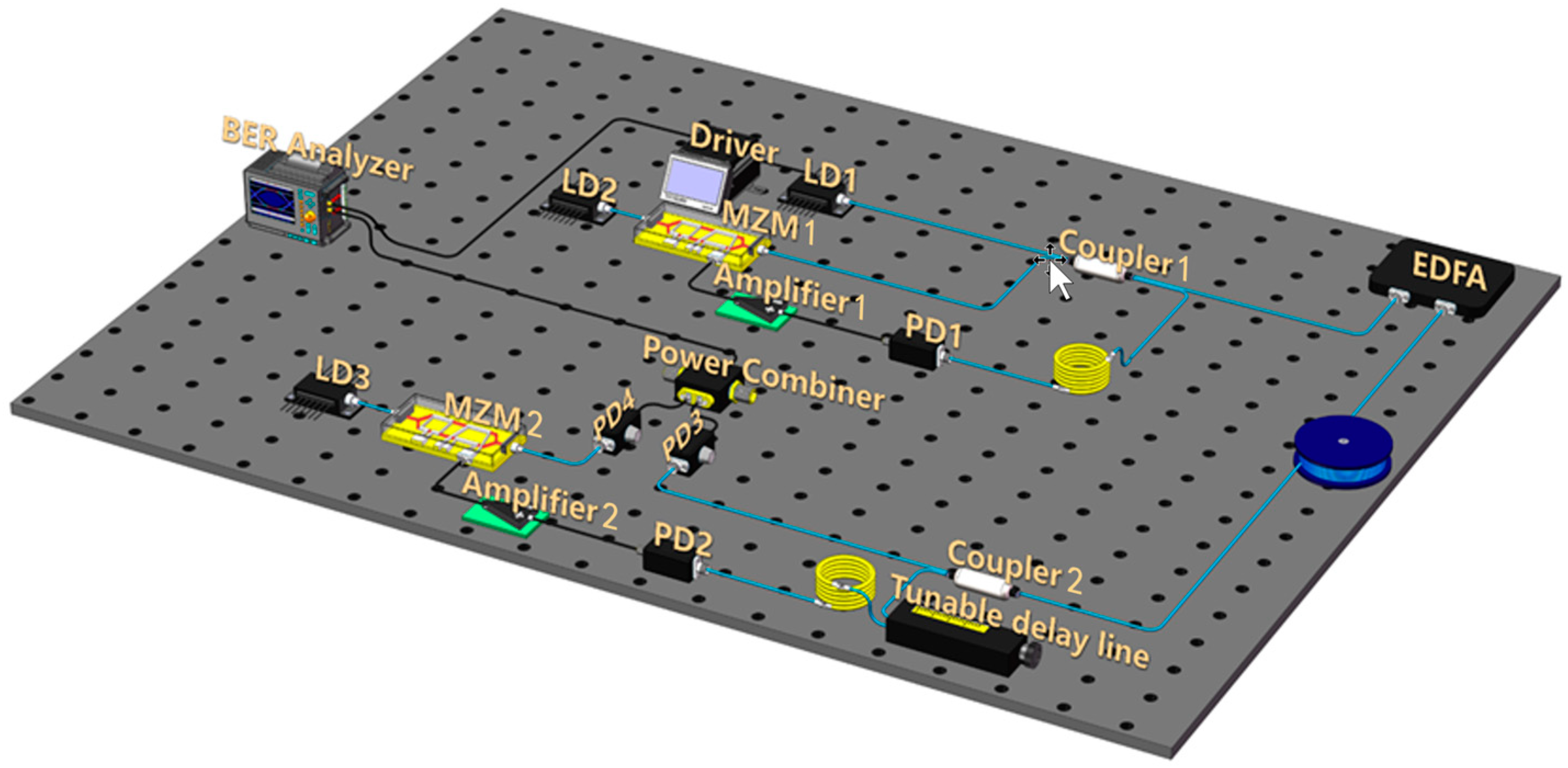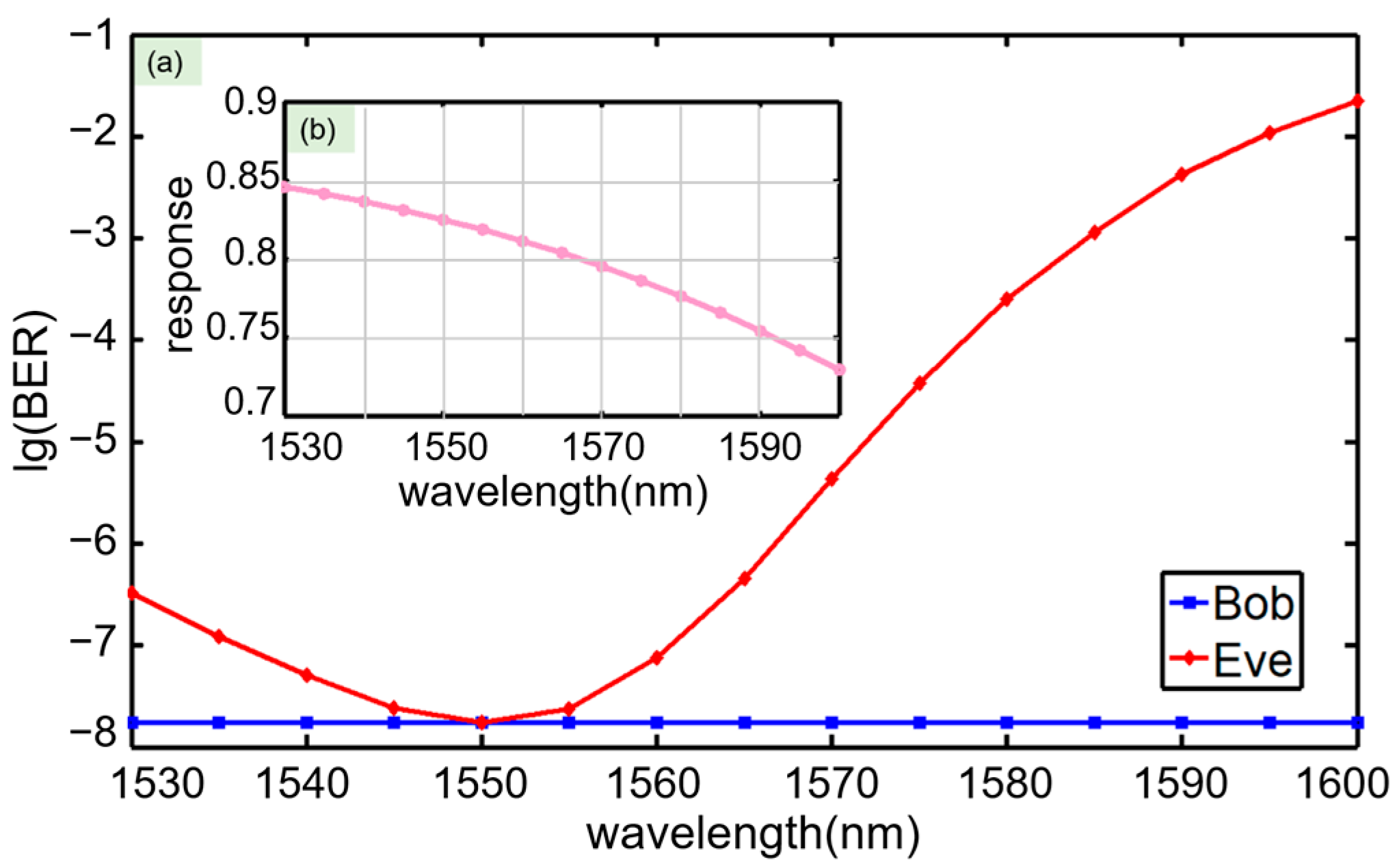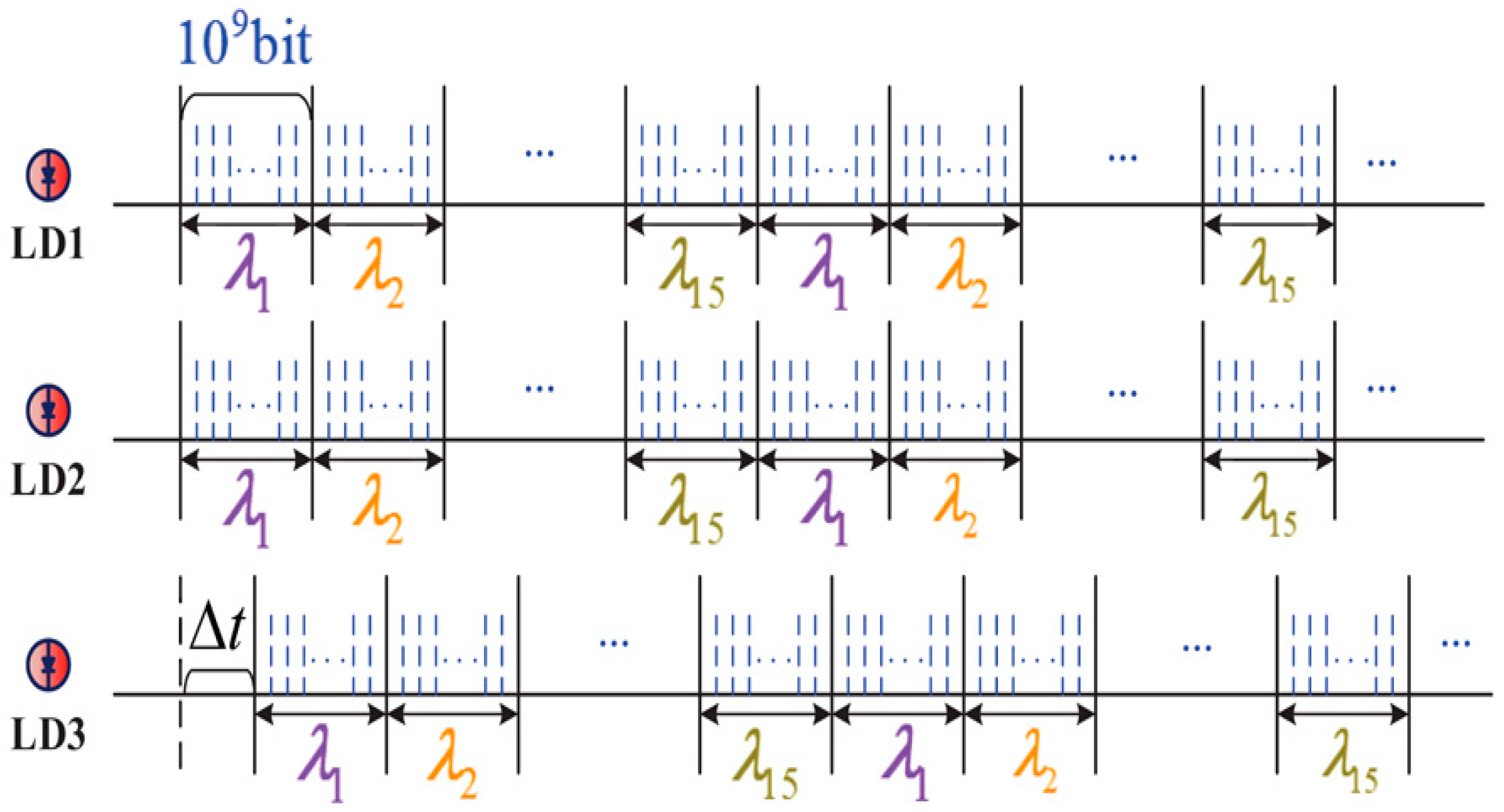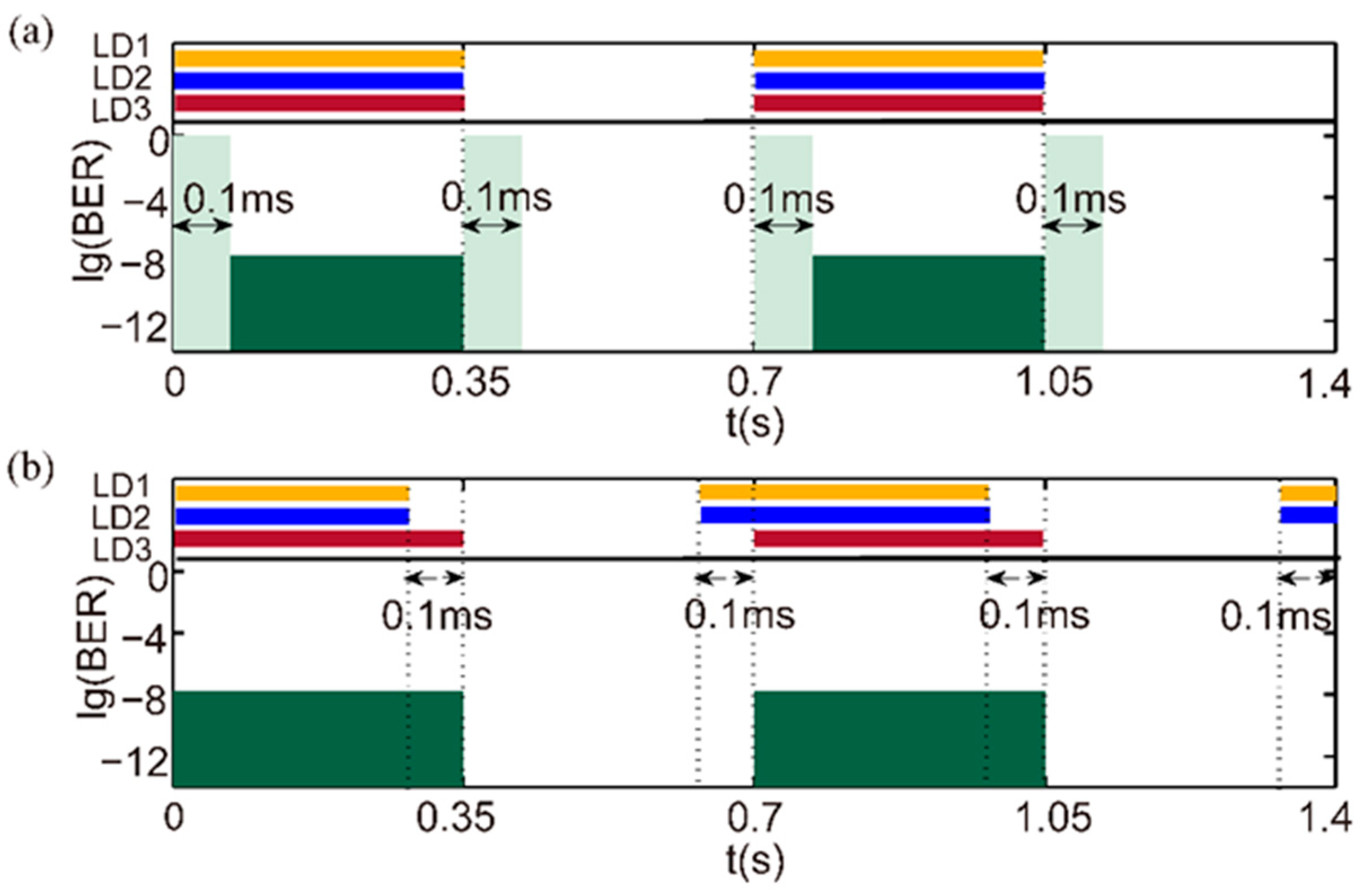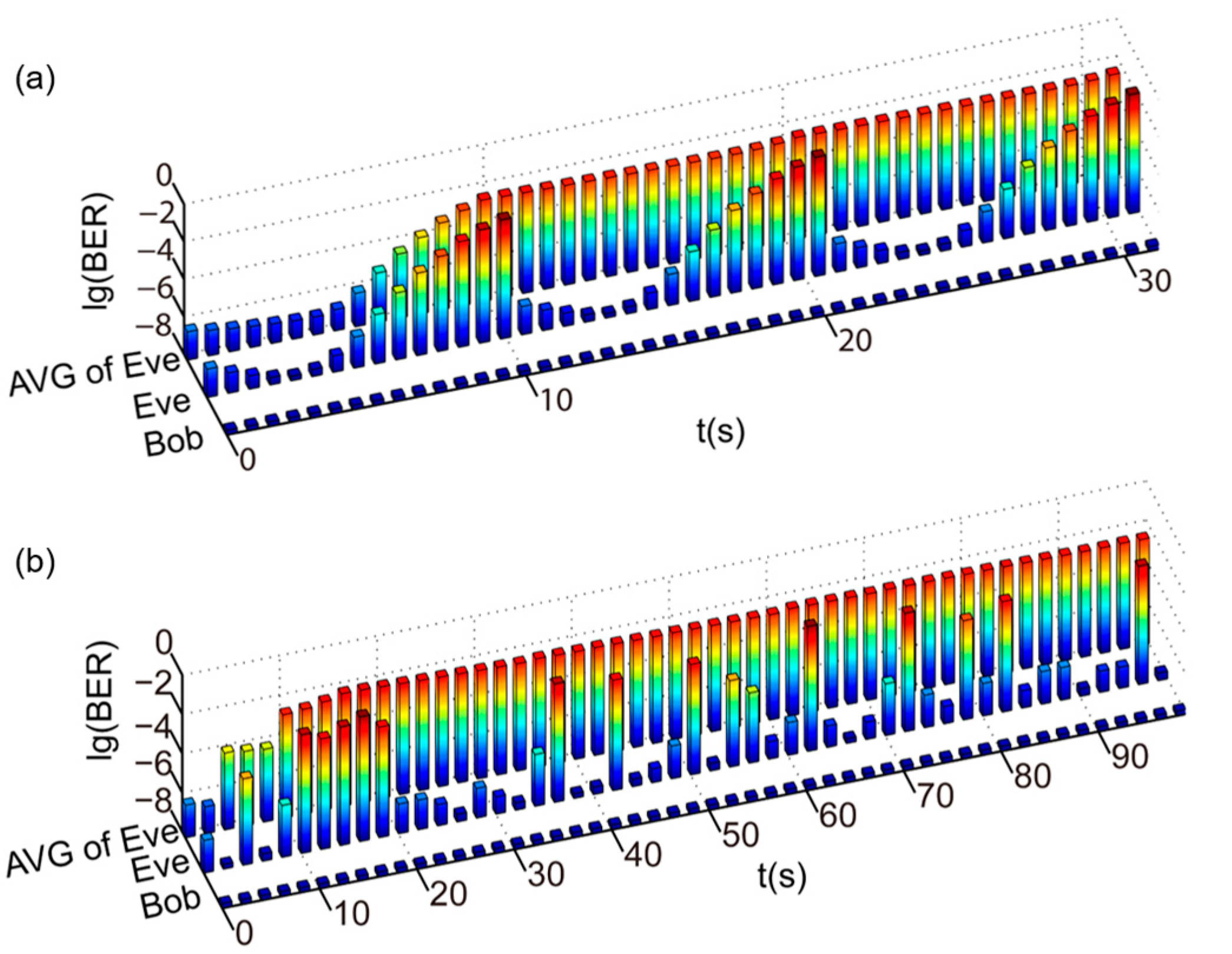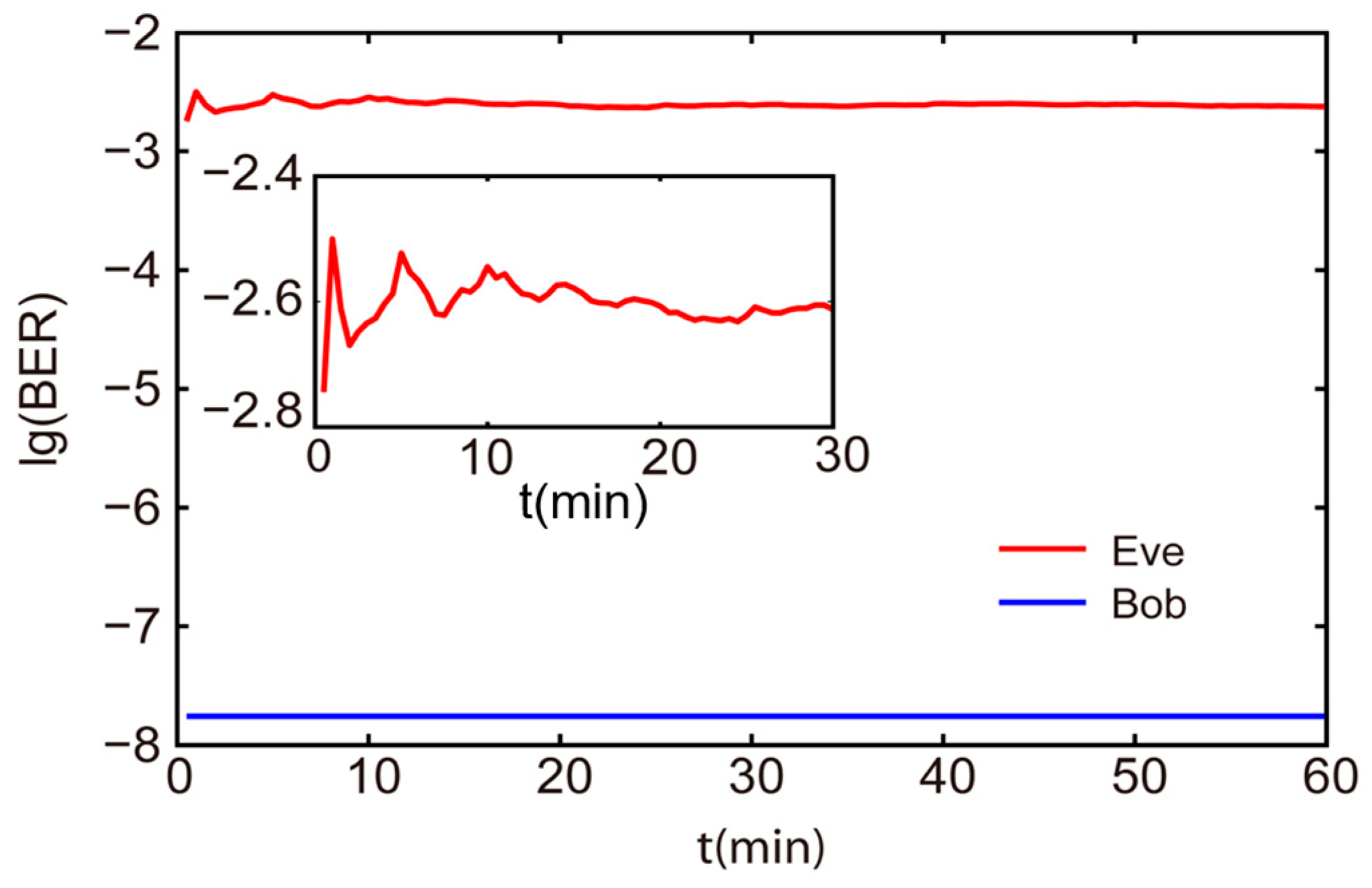1. Introduction
Fiber optic communication has previously been considered a kind of communication technology with high security. The epoch of absolute security in optical fiber communication continued until 2005 when researchers discovered the occurrence of eavesdropping on submarine cables. Therefore, a significant amount of research has recently focused on how to further improve the security of the optical fiber communication system. Chaotic communication has developed as a kind of encryption technology based on physical layers. The message in this type of communication system is added to the chaotic signal in the emitter and recovered by a receiver, which is synchronized with the emitter after transmission [
1]. Due to the high bandwidth of laser chaos, researchers mostly pay attention to the field of chaotic laser secure communication [
2,
3,
4,
5,
6], and in recent years, more new methods have been introduced to improve the performance of chaotic laser secure communication [
7,
8,
9]. There is also a significant amount of research on optoelectronic oscillators [
10,
11] and chaos generation [
12], which is helpful for designing the chaotic sources and then realizing the chaotic laser communication system.
Meanwhile, the confidentiality problem of chaotic laser communication systems has also been proposed by some scholars [
13,
14]. Attempts or experiments to recover the delay times [
15] and messages [
16] have been conducted, which have shown that it is necessary to enhance the security of chaotic laser secure communication. Additionally, to prevent the recovery of information, some schemes to further enhance the confidentiality of the chaotic laser communication systems have been proposed, such as subcarrier modulation [
17] and double masking [
18], and to prevent delay times, concealment technology of time delay has become a popular research topic in recent years [
19,
20,
21]. However, the above systems are complex and limited in application.
In this paper, by introducing the method of wavelength-hopping communication into chaotic laser communication, we propose a structure of a wavelength-hopping chaotic laser communication system based on tunable lasers. Due to the wavelength hopping and the pseudo-randomness of the wavelength-hopping sequence, it is difficult for the eavesdropper to intercept the information and predict to which wavelength the hopping station will hop. This will increase the demodulation mismatch of eavesdroppers and further increase the difficulty of obtaining the transmitting information. It also means that the introduction of wavelength-hopping technology will make the key to a chaotic communication system a dynamic variety process, while the traditional chaotic communication system is a static process. Therefore, it makes the key to a wavelength-hopping chaotic communication system much more complex than in a traditional system. Based on the wavelength-hopping chaotic laser communication system, the numerical results indicate that this structure can increase the bit error rate (BER) of the eavesdropper by five orders of magnitude under the same conditions, which greatly improves the difficulty of message decoding and improves the confidentiality of the system.
2. Principle
The wavelength-hopping chaotic communication scheme proposed in this paper is represented in
Figure 1. Based on the electro-optical feedback structure [
6], the optical intensity chaos is generated, and the chaotic synchronization is realized by using the emitter (Alice) and receiver (Bob) with the same structure and parameters.
In this system, a driver drives the tunable laser diode 1 (LD1), and LD1 is directly modulated by a digital message m(t). Initially, the optical signal c1(t) emitted by the tunable laser diode 2 (LD2) passes though Mach–Zehnder electro-optical modulator 1 (MZM1). Then it is split into two branches by fiber coupler 1. One output c1(t)/2 of coupler 1 in the emitter is transmitted to the receiver directly, and when the signal is applied to Mach–Zehnder electro-optical modulator 2 (MZM2) in the receiver, the output of MZM2 can be written as c2(t). The other output c1(t)/2 of coupler 1 is fed back to MZM1 through photodiode 1 (PD1) and amplifier 1, and the output of MZM1 can be also written as c2(t). Then c2(t) arrives at coupler 1 again. At the same time, a digital message m(t), which comes from LD1, also arrives at coupler 1. Then, through fiber coupler 1, the signal composed of c2(t) and m(t) is transmitted to the receiver.
Finally, in the receiver, the first signal composed of c2(t) and the second signal composed of c2(t) and m(t) are detected by photodiode 3 (PD3) and photodiode 4 (PD4). Then, the two branches of the signal are converted into electrical signals, and the message signal can be found by subtraction. The decoded message is analyzed by a BER analyzer. The erbium-doped fiber amplifier (EDFA) is used to compensate for the loss in the optical fiber transmission channel and the beam-splitting loss of the coupler at the receiver, to ensure that the optical power into the feedback loop of the emitter and the receiver is equal.
Different from the chaotic optical fiber communication systems in previous works, tunable lasers are used in this system in both the emitter and the receiver. The wavelength of tunable lasers is kept a secret key between Alice and Bob. In the process of communication, a pseudo-random sequence generator controls the selection circuit of the laser wavelength, so the wavelengths of the lasers in the emitter and the receiver hop within a certain range synchronously and at pseudo-random.
For a chaotic system, nonlinear dynamics are very important [
22]. In a chaotic communication system, the BER is mainly affected by the mismatch noise, and in our system, the root mean square amplitude of the mismatch noise is affected by the wavelength. Based on Ref. [
23], considering the effect of the wavelength, <
nλ2> can be approximated as
where Δ
ϕ is the mismatch offset phase, Δ
Kλ is the mismatch of detection and can be given as Δ
Kλ =
Kλ′ −
Kλ.
Kλ, and
Kλ′ can be expressed as
where
PT and
PT′ are the optical power of the emitter laser and the receiver laser, respectively, and
gAPD and
g′
APD are the gain of PD3 and PD4, respectively. The gain of the EDFA is
gEDFA, and
αT is the loss in the transmission line. In order to realize the parameter match,
gEDFAαT/4 = 1 is used. The response of PD3 and PD4 are given as
Rλ and
Rλ′, and they are the function of
λ and
λ′, respectively. For a given PD, the spectral response curve versus the wavelength is particular, and the shape of the curve is related to the device materials of PD. For a commercial PD, its spectral response can be obtained from the product manual. The synchronization error is <
ε2> and is not affected by the wavelength. It can be expressed as [
23]
where Δ
T is the mismatch of the time delay, Δ
β is the mismatch of the overall normalized electro-optic oscillator gain,
β is the overall normalized electro-optic oscillator gain, Δ
τ is the mismatch of the high cutoff response time, and
τ is the high cutoff response time.
The signal to noise ratio (SNR) is also affected by the wavelength. Based on Ref. [
23], the SNR of our system can be expressed as
where
α is the masking efficiency. The probability density function (pdf) of the mismatch noise can be expressed as a function of a Gaussian distribution and its derivatives. With proper tuning, the coefficients of the derivatives can converge to zero [
23]. Thus, the mismatch-induced BER of the system can be given by
When this system works normally, always set ΔKλ close to zero so that the BER always takes a small value. For Eve, since the secret key of the hopping sequence of the wavelength is not available, the responses of PD3 and PD4 are not the same. Even though their structures are the same as the receiver, ΔKλ will increase because of the detector mismatch, and then the BER of Eve will increase. This can explain why this system can improve the confidentiality of chaotic communication.
3. Numerical Simulation and Analyses
We now further analyze the security of the wavelength-hopping chaotic communication system in detail. Considering the performance of chaotic communication systems [
23], and based on our system, the parameters of the numerical simulation are shown as follows: emitter power
PT = 5 mW, mask efficiency
α = 0.2, time delay mismatch Δ
T = 1 ps, strength feedback mismatch rate Δ
β/
β = 0.004, offset phase mismatch Δ
ϕ = 0.02 rad, high cutoff response time mismatch rate Δ
τ/
τ = 0.02, and the distance of optical fiber transmission channel is 30 km.
For the photodetector, we took a typical photodetector as an example, and its spectral response is given in the product manual (the spectral response between 1530 nm and 1600 nm is shown in
Figure 2b).
Figure 2a shows the BER of Bob and Eve under different emitter wavelengths (from 1530 nm to 1600 nm, C band and L band) based on this PD. It can be seen that the BER remains below 10
−7 when the laser wavelength of the emitter is synchronized with that of the receiver. When the wavelength of the receiver remains at 1550 nm, with an increase of the wavelength of the emitter, the BER first decreases; it reaches its lowest value when the wavelength of the emitter is also 1550 nm, and then it increases soon after. The BER reaches up to 10
−2 when the wavelength of the emitter is 1600 nm. It is always higher than 10
−6 when the wavelength of the emitter ranges from 1570 nm to 1600 nm and is higher than 10
−3 in the range of 1585 nm to 1600 nm.
Since the wavelength of this chaotic system is hopping, the wavelength control of the three tunable lasers in the emitter and receiver is of particularly note. As shown in
Figure 1, there is an optical fiber transmission channel between the emitter and receiver, which is tens or even hundreds of kilometers long in practical communication. The time when the signal transmits in the feedback loop can be written as
t, and the time when the optical signal transmits in the optical fiber channel can be written as Δ
t. Thus, after the split by the coupler of the emitter, a part of the signal applies to the MZ modulator of the emitter and generates a chaotic signal, which takes the time
t, and the wavelength of the chaotic signal can be written as
λ1. Similarly, another part of the signal applies to the MZ modulator of the receiver and generates a chaotic signal, which takes the time
t + Δ
t, and the wavelength of the chaotic signal can be written as
λ2. Since the chaotic signal generated by the emitter also takes the time Δ
t to transmit to the receiver, it is possible to recover the message by subtracting the two input signals of the power combiner if
λ1 =
λ2.
The wavelength-switching sequence of the three tunable lasers is shown in
Figure 3. In terms of LD1, in order to make the message signal and the chaotic carrier signal not be separated in the optical fiber transmission channel, the wavelength-switching moment and sequence of LD1 should be synchronous with that of LD2. For LD2 and LD3, their wavelength-switching sequences and time intervals should be controlled uniform, and the wavelength switching of LD3 should have a time delay Δ
t relative to LD2. The value Δ
t can be expressed as
where
L is the distance of the optical fiber transmission channel and
c is the speed of light in the fiber.
Figure 4 shows the BER of this system when the wavelength switching of LD3 has a time delay or no time delay relative to that of LD2. The tunable time of the tunable lasers we chose is 350 ms/5 nm, and in this period, the message stops transmitting because of the unstable wavelength. We assume that the working time of the lasers in each wavelength is 350 ms and that the optical fiber transmission channel is 30 km long; thus, the time delay of LD3 is 0.1 ms. In the case of not considering the time delay, in the first 0.1 ms, since the signal of the receiver achieves the power combiner when the signal of the emitter is transmitting in the channel, the value of the BER is 1. Between 0.1 ms and 0.35 s, even though the time delay is not considered, the wavelength of the two input signals of the power combiner is the same, and the BER is not affected. Within the 0.1 ms after 0.35 s, LD3 has worked for 0.35 s and is in a state where it is unable to switch wavelengths. However, there is the signal emitter by LD2 with input to the power combiner during this time, and the value of BER is 1. In the following period, the BER changes periodically according to this rule. This shows that when designing the system, it is necessary to consider the time delay of the laser LD3.
We set the wavelength of the tunable laser of the transmitter to switch once every 5 nm from 1530 nm to 1600 nm, for a total of 15 wavelengths, which is a period. The tunable laser wavelength switching time of the 5 nm interval is 350 ms, and we set the working time of each wavelength to 350 ms; each period is then 11.2 s. The wavelength switching of LD3 is set as mentioned above, and the laser wavelength of the eavesdropper is assumed constant, always at 1550 nm. In
Figure 5a, the BER always stays below 10
−7 and remains almost unchanged during authorized communication between Alice and Bob. For Eve, since the wavelength of the tunable laser in the emitter is constant during the working time, the BER is constant during this period. When the wavelength of the emitter is switched, the BER also hops with it. The BER of Eve changes periodically with the periodic hopping of the wavelength of the emitter. It decreases at first and then increases, reaching the maximum at the end of the period. In addition, we use the average BER to show the BER of Eve within the previous time. After a few seconds, with the increase in the BER of Eve, the average BER also increases and remains at a relatively high value. The value of the average BER of Eve in one period is 2.6 × 10
−3, which is five orders of magnitude higher than the BER of Bob. Due to the lack of forward error correction (FEC) technology in our transmitting subsystem of the chaotic optical communication system, the BER of systems must be less than 10
−6. Therefore, Bob can transmit communication normally and Eve cannot. In addition, in order to study the worst-case scenario, we conduct a numerical analysis and evaluation based on the assumption that Eve knows the key to our chaotic communication system accurately except for the wavelength hopping. In fact, the BER of Eve will be much worse than in the case described here because Eve cannot accurately master our key parameters.
In order to further improve the security of the system, we refer to the wavelength-hopping communication and use a pseudo-random sequence generator to control the wavelength selection circuit of the laser. The pseudo-randomness of the wavelength sequence makes it more difficult for Eve to predict to which wavelength the laser will hop. In order to ensure high-quality demodulation of chaotic communication systems, the information should be uploaded to the tunable laser when it is in a stable working state after each laser wavelength switching occurrence. The tuning time of the tunable laser through 100 nm is 1 s, so we set the system to suspend communication for 1 s when switching wavelengths, and the working time of each wavelength is also 1 s. Although it may affect transmission efficiency, we can compensate for this problem by increasing the transmission data rate. In addition, improving the stable switching speed of the tunable laser is also effective.
Figure 5b shows the BER of Bob and the BER of Eve as a function of time within 60 s when the wavelength is switched pseudo-randomly. The BER of Bob still remains below 10
−7, which is the same as the BER when the wavelength is switched periodically, while the BER of Eve hops pseudo-randomly due to the switched wavelengths.
In the same way as the wavelength switched periodically, we use the average BER to compare the BER of Bob and the BER of Eve in total when the wavelength switched pseudo-randomly. Although the BER of Eve does not have a periodic rule when the wavelength is switched pseudo-randomly, due to the properties of the pseudo-random sequence, the average BER of Eve should be stable when the test time is long enough.
Figure 6 shows the average BER of Bob and the average BER of Eve as the test time changes. Within the first 20 min, since the pseudo-random sequence is still relatively short, the BER of Eve oscillates between 10
−2 and 10
−3. After 30 min, with the increase in length of the pseudo-random sequence, the BER of Eve gradually stabilizes around 2.6 × 10
−3. It also indicates that this method of wavelength hopping pseudo-randomly can improve the security of the system.
